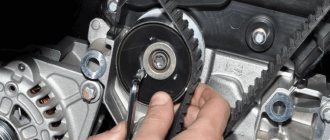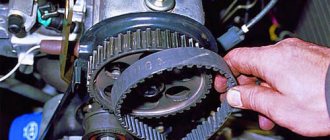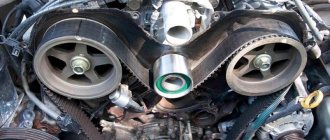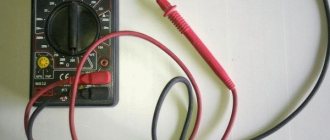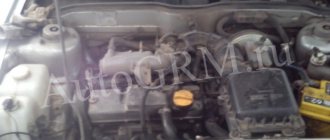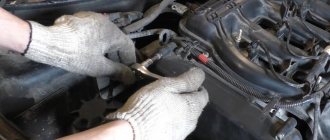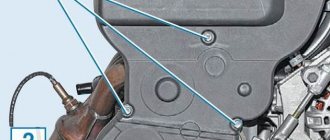04.07.2019
| (No votes) |
Issues discussed in the material:
- Why do you need a timing belt?
- Why does a new timing belt break?
- How to understand that the timing belt has broken
- What are the consequences of a broken timing belt?
- How to replace a timing belt
- Which timing belt is best to buy for replacement?
The purpose of the timing belt is to participate in the process of converting the energy generated during fuel combustion into a force that drives the wheels by acting on them through the transmission. There are several types of such drives. Depending on the material and design, there are rubber ones, which are a solid ring, and metal ones, which are in the form of a chain. During use, any drive is subject to wear and tear and, accordingly, will eventually break. But in the case when a new timing belt breaks, you should understand what was the reason.
Purpose of the timing belt
Thanks to the drive, all timing systems are put into operation, due to which the camshaft and crankshaft are combined and the car starts to move.
When the camshaft rotates, a mixture of fuel and air enters the cylinders of the internal combustion engine; the remaining gas mixture is removed after processing through the exhaust system.
If the gas distribution mechanism drive breaks or breaks, the entire process of engine operation is disrupted, and, as a result, serious problems may arise.
When the timing drive breaks, the camshaft stops, the valves of which freeze in the position where they were at the time of the break. In this case, the gas mixture inside the chamber is still burned, as a result of which the resulting energy pushes the engine pistons onto the valves frozen in one position. The most common scenario is deformation of the valves under piston pressure. If the valves are stronger, they can pierce the piston at the top.
Both options mean expensive engine repairs. If the design of the engine is designed in such a way that if the new timing belt breaks, the pistons do not mate with the valves, the car owner will only have to replace the drive.
We recommend
“Diesel engine timing belt: features of operation and replacement” Read more
Breakage of a new timing belt: common causes
- Incorrect operation. A break in the new timing belt may result from improper operation of the entire assembly. For example, when driving, the tensioners, rollers or pump may jam, which will lead to a break in the new timing belt.
Despite the external quality of this part, when a high crankshaft rotation speed is reached, a sharp change in operating conditions can damage it.To prevent the new timing belt from breaking, you need to carefully monitor its tension. Excessive tightening can also cause part failure. However, by loosening the drive too much, you can get a similar result due to the belt jumping off the pulley grooves.
This situation can also arise if there is existing pulley play. That is why, in order to prevent engine damage, it is necessary not only to change the timing belt in a timely manner, but also to monitor its tension and the proper operation of each element of the mechanism in order to prevent breakage.
- Oil getting on the surface.
If you notice traces of oil or antifreeze on the new belt, this means that it needs to be replaced.If you do not install a new belt, the entire gas distribution mechanism will not work efficiently. The drive will slip, be removed from the pulley, and eventually break.
Don't think that just by wiping off an oil stain you can continue driving without taking any action. It is not possible to completely remove traces of oil from a new drive. After technical fluid gets on it, it is absorbed, depriving the drive of the qualities necessary for proper operation. Only replacing it with a new drive will help here.
- Low quality product.
If you saved money by buying a timing belt, then you need to be prepared for the fact that troubles may arise during its operation. This is a case where the stingy pays twice, because a broken new timing belt can lead to high engine repair costs. We recommend purchasing an original drive from a seller whose quality you are confident in.Car service workers know well how an attempt to save a couple of hundred rubles can result in repairs costing tens of times more. There is nothing surprising here, since a low-quality new timing drive can break without traveling even a couple of tens of thousands of kilometers. Constantly expecting a catch from such an important detail, you worry, which leads to driving mistakes and uncertainty in your own car.
- External damage.
If the drive has served you for a long time or it was of poor quality to begin with, it may develop external damage, such as cracks, grooves, loose threads, and the like. These shortcomings cannot be eliminated. If such damage is present, a new drive must be installed as soon as possible.Ignoring wear can lead to the fact that under load the defect will intensify and a breakage will occur. It is better to anticipate and prevent this situation than to blame yourself later and pay for expensive repairs and a new drive.
- Harsh climate and active driving.
In many regions of Russia, the climate is such that the car is regularly exposed to too high or low temperatures. Therefore, car repair and maintenance must be approached with special care. Sudden changes in temperature can affect the wear of the new timing belt, which increases the likelihood of it breaking. In such conditions, it is better to use only original components for repairs and change the drive at the first signs of wear, without waiting for the expiration of the service life declared by the manufacturer. - Failed rollers very quickly lead to abrasion of the surface and the new timing belt breaks.
The purpose of the rollers is to support the drive in a tense position. It is thanks to them that the timing belt does not slip and does not fly off the teeth. If the rollers malfunction, they jam and the new drive quickly fails or breaks.
We recommend
“How to check the timing belt and which one to choose as a replacement” Read more
Causes
There are many factors that cause a break:
- Contact of oils and dirt on the rubber coating. To prevent this from happening, this unit is carefully closed with a plastic case, which is secured with bolts on both sides. When an element breaks or is replaced, this casing is often deformed, which is why foreign objects can re-enter the surface of the mechanism.
- Natural wear and tear of the element or a manufacturing defect.
- Water pump wedge, or in common parlance “pump”. It is closely interconnected with the operation of this mechanism.
- Wedge of tension roller, camshaft or crankshaft. It is very difficult to cause a breakdown of the last two, which cannot be said about the pump or the roller.
How to understand that a new timing belt has broken
Typically, if the timing belt breaks, the engine will stop immediately under other normal conditions. When further attempts are made to start the engine, this cannot be done, or in difficult cases a metal knock is heard. The break of a new timing belt is accompanied by a bang, but if the radio is running in the car at the same time, you may well miss this sound.
If you suspect that the new timing belt has broken, stop immediately and inspect the vehicle by opening the hood. This breakdown is immediately noticeable. You should not try to restart the engine before inspection if you think that a break has occurred. After all, when starting an engine with a broken drive, the valves may bend, and the breakdown will only worsen.
We recommend
“Stages of engine diagnostics: what determines the sequence of work” Read more
Cost of work
If the timing belt breaks (including 2112) without bending the valves, the cost of replacing it will be about 500 rubles. But if you have certain skills, you can do it yourself. Thus, the breakdown budget will be no more than a thousand rubles.
At the same time, it is recommended to check the condition of the pump impeller and tension roller - they should rotate smoothly, without sounds or play. If a wedge occurs and valves need to be replaced and the cylinder block repaired, the cost of the work can reach 40-50 thousand rubles. If it is an old foreign car, it is easier to install a contract engine from disassembly - in some cases it is actually cheaper than repairing the old one. Well, in order to prevent such a situation, monitor the tension of the element and its external condition, and most importantly, observe the replacement frequency of 60-80 thousand kilometers. Even if after this period the belt does not pose a danger (without deformations or extraneous sounds), it would not be superfluous to play it safe by installing a new element in its place.
So, we found out what to do if the timing belt breaks.
Consequences of a broken timing belt
Despite the apparent simplicity of the problem, its consequences can be quite serious. If you are faced with a break in a new drive, you may need either a simple replacement of this part or a major overhaul of the engine with restoration of the timing belt.
Frequent consequences of a broken new timing belt:
- The need for a major engine overhaul.
- Damage to the gas distribution mechanism.
- Valve deformation - can occur when the actuator breaks when lowering them. Under the influence of inertial force, the crankshaft continues to rotate, resulting in a collision between the pistons and valves. This can happen if the car is designed with a reduced combustion chamber and there are no recesses on the pistons.
To determine the extent of damage, it would be best to transport the car to a service station, since it will be necessary to dismantle the cylinder head and diagnose the engine using special equipment.
It is best to determine what exactly happened to the car and to what extent the engine was damaged directly at the service station. To do this, you need to have special equipment that allows you to disassemble the cylinder head. If several valves are deformed, it is still better to replace the entire set. On Japanese-made cars, a piston malfunction is often diagnosed in such cases. This occurs due to a strong impact on the valve heads.
When a new timing belt breaks while driving at high speed, the valves are bent and the bushings and pistons are destroyed. This entails expensive repairs and replacement of the head.
For diesel engines, breaking a new timing belt has significant consequences. These power units are designed in such a way that the valves hardly move, so when a break occurs, they are simultaneously destroyed:
- camshaft bearings;
- block head;
- connecting rods;
- valves
The only way to assess how seriously damaged the engine is is to remove the head and see the condition of the valves and pistons. Visual inspection is not always effective; to detect a malfunction, you may need equipment that is only available at specialized service stations.
We recommend
“Why does the engine smoke: diagnostics, repair, prevention” Read more
Diesel
No matter what horror stories are told about eight- and sixteen-valve gasoline engines, the most serious consequences still occur with diesel units.
Due to their more complex design, the valves have almost no travel in the TDC position. Therefore, if the timing belt of a diesel engine breaks, deformation of a number of components will occur. These are camshafts with bearings, connecting rods (as shown in the photo above) and tappets. The cylinder block must also be replaced.
Possible costs and procedure for replacing a timing belt
One valve costs approximately 1000 rubles. This is the price of the part without other costs. It is quite possible that sixteen valves will have to be replaced.
You will also need to purchase:
- Timing belt or replacement kit, which contains a tensioner and idler pulley.
- Gaskets for intake and exhaust manifolds.
- Cylinder head gaskets and valve covers.
- Mounting bolts.
- If worn, a pump may be required.
To replace it, you need to find a place where there is a lift.
To make a replacement, you need to stock up on the necessary keys, screwdrivers, alignment pins for timing marks, and, if necessary, special tools.
Algorithm for dismantling the old timing belt to install a new one:
- Unscrew the bolts that secure the timing case.
- Unscrew the bolts that secure the crankcase protection.
- Remove the compressor belt. To do this, it is necessary to dismantle, remove the drive and install the compressor in its original place.
- Remove the alternator belt. To de-energize all contacts, you need to remove the terminal located on the battery.
- Unscrew the bolts on the engine and remove the generator, pump pulley and terminal, removing the bolts that hold them in place. It may be necessary to remove the engine mount.
- Remove the cover protecting the timing belt.
- Remove the toothed pulley cover. Remove the faulty timing belt. Install the new drive, tightening the tensioner properly. If the roller mechanism is faulty, it must also be replaced. Then the entire structure must be assembled in reverse order. Different brands of cars have certain design features, although the general principle of operation is the same.
We recommend
“Checking the hand brake: signs of malfunction and their elimination” Read more
How to extend the life of your timing belt
The main preventive measure to prevent unexpected timing belt breakage is its timely replacement with a new one. Experts recommend doing it after every sixty thousand kilometers. Try to use original new components.
The entire mechanism of the gas distribution system must be regularly checked for serviceability. This is especially true for the roller system and pump. The tension of a new belt in good condition is uniform. It shouldn't sag.
To prevent the new timing belt from breaking, the following points should be monitored:
- The degree of oil pressure indicated by the warning lamp.
- Serviceability of seals. If they leak oil, the belt will quickly become unusable. If you notice oil stains on the surface of the asphalt or engine, you should eliminate the causes of these leaks.
- Do not use the push start method. This provokes a quick break of the new timing belt.
By following these measures, you will reduce the likelihood of a new drive suddenly breaking. But this does not provide a 100% guarantee of preventing a break. Therefore, it is best to carry with you all the necessary tools and new components for replacement.
Care must be taken to periodically inspect the new drive and replace it when it is faulty. This will prevent breakage and maintain the integrity of the engine.
We recommend
“Frequency of oil changes in a car: timing and recommendations” Read more
Replacement
If the timing belt breaks (whether it’s a VAZ or a foreign car, it doesn’t matter), the first step is to install a new element. There are two reasons for the impending replacement:
- Natural wear and tear. Manufacturers recommend replacing the element at least once every 80 thousand kilometers. However, it is not uncommon for a belt to “nurse” for 150-200 thousand without deformation or whistling. But this does not mean that the replacement can be postponed indefinitely. This can lead to expensive repairs.
- Mechanical damage. The belt structure may be damaged due to gross errors during installation. This is a mismatch of marks, insufficient or excessive tension of the element. Also, the belt breaks (more often than not it simply falls off) during active driving “before the cut-off”, which is accompanied by sharp braking. If the car is “chipped” with a cutoff offset, there is a high probability of a belt break. Therefore, you should not often operate the car under heavy loads.
